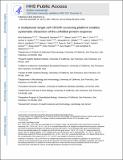A Multiplexed Single-Cell CRISPR Screening Platform Enables Systematic Dissection of the Unfolded Protein Response
Author(s)
Adamson, Britt; Norman, Thomas M.; Jost, Marco; Cho, Min Y.; Nuñez, James K.; Chen, Yuwen; Villalta, Jacqueline E.; Gilbert, Luke A.; Horlbeck, Max A.; Hein, Marco Y.; Pak, Ryan A.; Gray, Andrew N.; Gross, Carol A.; Parnas, Oren; Weissman, Jonathan S.; Dixit, Atray C.; Regev, Aviv; ... Show more Show less
Downloadnihms832990.pdf (3.046Mb)
PUBLISHER_CC
Publisher with Creative Commons License
Creative Commons Attribution
Terms of use
Metadata
Show full item recordAbstract
Functional genomics efforts face tradeoffs between number of perturbations examined and complexity of phenotypes measured. We bridge this gap with Perturb-seq, which combines droplet-based single-cell RNA-seq with a strategy for barcoding CRISPR-mediated perturbations, allowing many perturbations to be profiled in pooled format. We applied Perturb-seq to dissect the mammalian unfolded protein response (UPR) using single and combinatorial CRISPR perturbations. Two genome-scale CRISPR interference (CRISPRi) screens identified genes whose repression perturbs ER homeostasis. Subjecting ∼100 hits to Perturb-seq enabled high-precision functional clustering of genes. Single-cell analyses decoupled the three UPR branches, revealed bifurcated UPR branch activation among cells subject to the same perturbation, and uncovered differential activation of the branches across hits, including an isolated feedback loop between the translocon and IRE1α. These studies provide insight into how the three sensors of ER homeostasis monitor distinct types of stress and highlight the ability of Perturb-seq to dissect complex cellular responses.
Date issued
2016-12Department
Institute for Medical Engineering and Science; Massachusetts Institute of Technology. Department of BiologyJournal
Cell
Publisher
Elsevier
Citation
Adamson, Britt et al. “A Multiplexed Single-Cell CRISPR Screening Platform Enables Systematic Dissection of the Unfolded Protein Response.” Cell 167, 7 (December 2016): 1867–1882 © 2016 Elsevier Inc
Version: Author's final manuscript
ISSN
0092-8674
1097-4172